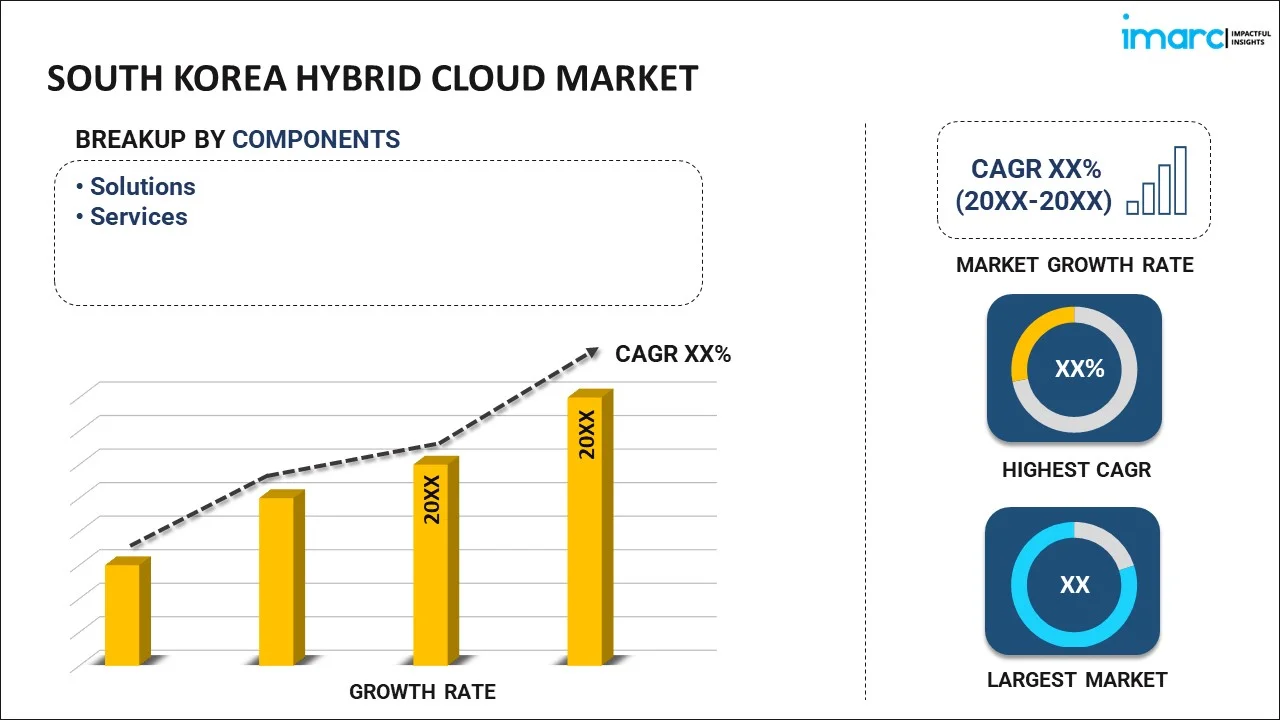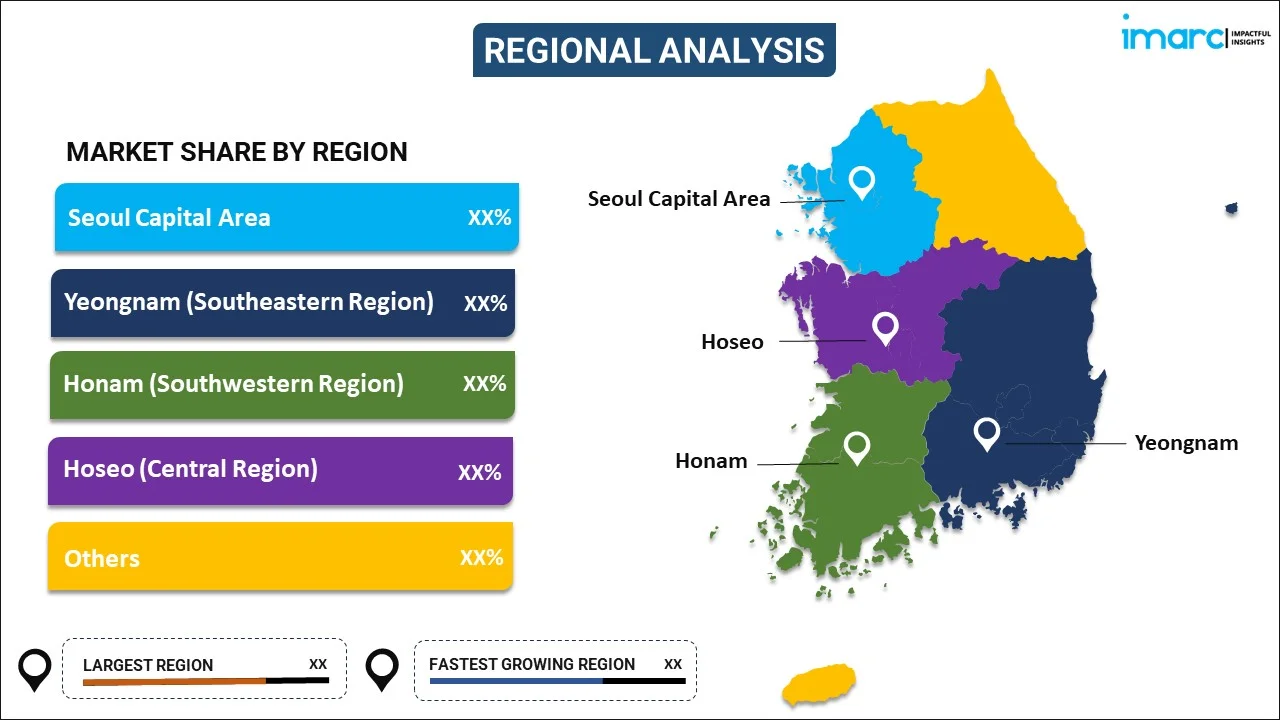
South Korea Hybrid Cloud Market Report by Component (Solutions, Services), Organization Size (Small Enterprises, Medium Enterprises, Large Enterprises), Vertical (Government and Public Sector, Healthcare, Banking, Finance, Services, and Insurance (BFSI), Retail, Information and Communication Technology, Manufacturing, and Others), and Region 2024-2032
Market Overview:
South Korea hybrid cloud market size is projected to exhibit a growth rate (CAGR) of 21.81% during 2024-2032. The escalating digital transformation of businesses, increasing adoption of the Internet of Things (IoT) and artificial intelligence (AI), imposition of supportive government policies, and rapid expansion of e-commerce and online services represent some of the key factors driving the market.
|
Report Attribute
|
Key Statistics
|
|---|---|
|
Base Year
|
2023 |
|
Forecast Years
|
2024-2032
|
|
Historical Years
|
2018-2023
|
| Market Growth Rate (2024-2032) | 21.81% |
A hybrid cloud is a computing environment that integrates public and private clouds, allowing data and applications to be shared between them. It offers excellent flexibility and more deployment options, enabling businesses to optimize their existing infrastructure, security, and compliance. A hybrid cloud is comprised of several components, such as public cloud services, private cloud infrastructure, and a seamless network connecting them. It is widely used for disaster recovery, big data analytics, customer relationship management (CRM), enterprise resource planning (ERP), and content management. Hybrid cloud is known for its cost efficiency, scalability, flexibility, improved collaboration, and enhanced security. In addition, it provides several advantages, such as improved data management, greater operational efficiency, a strategic edge in competitiveness, streamlined workflows, and robust compliance and security measures.
South Korea Hybrid Cloud Market Trends:
The escalating digital transformation of businesses across various sectors in South Korea, fueling the need for improved operational efficiency and data management capabilities, is boosting the market growth. Additionally, the increasing adoption of Internet of Things (IoT) and artificial intelligence (AI) technologies in South Korea, which necessitates a hybrid cloud infrastructure to handle the vast amount of data generated, is boosting the market growth. Besides this, the imposition of supportive government policies and investments in cloud computing and digital infrastructure is contributing to the market growth. Furthermore, the rapid expansion of e-commerce and online services in South Korea is facilitating the demand for a hybrid cloud as businesses seek scalable and secure cloud solutions to handle increasing online traffic and data. In addition, the heightened need for disaster recovery solutions amidst rising cybersecurity threats is catalyzing the market growth. Apart from this, the heightened awareness about the flexibility and scalability of hybrid cloud systems, making them ideal for handling unpredictable workloads and storage demands, is supporting the market growth. Moreover, the ongoing shift towards remote work and online collaboration, leading to increased reliance on cloud technologies, including hybrid cloud solutions, is bolstering the market growth. Along with this, the growing emphasis on data sovereignty and local data storage regulations in South Korea, prompting businesses to adopt hybrid cloud solutions, as they offer a balance between local and global data management, is driving the market growth. Furthermore, the increasing importance of data analytics and real-time data processing in decision-making processes, which necessitates the adoption of hybrid cloud systems, is accelerating the market growth. Additionally, the growing awareness and understanding of cloud technologies among South Korean businesses is providing a considerable boost to the market growth.
South Korea Hybrid Cloud Market Segmentation:
IMARC Group provides an analysis of the key trends in each segment of the market, along with forecasts at the country level for 2024-2032. Our report has categorized the market based on component, organization size, and vertical.
Component Insights:

- Solutions
- Services
- Professional Services
- Managed Services
The report has provided a detailed breakup and analysis of the market based on the component. This includes solutions and services (professional services and managed services).
Organization Size Insights:
- Small Enterprises
- Medium Enterprises
- Large Enterprises
A detailed breakup and analysis of the market based on the organization size have also been provided in the report. This includes small enterprises, medium enterprises, and large enterprises.
Vertical Insights:
- Government and Public Sector
- Healthcare
- Banking, Finance, Services, and Insurance (BFSI)
- Retail
- Information and Communication Technology
- Manufacturing
- Others
The report has provided a detailed breakup and analysis of the market based on the vertical. This includes government and public sector, healthcare, banking, finance, services, and insurance (BFSI), retail, information and communication technology, manufacturing, and others.
Regional Insights:

- Seoul Capital Area
- Yeongnam (Southeastern Region)
- Honam (Southwestern Region)
- Hoseo (Central Region)
- Others
The report has also provided a comprehensive analysis of all the major regional markets, which include Seoul Capital Area, Yeongnam (Southeastern Region), Honam (Southwestern Region), Hoseo (Central Region), and Others.
Competitive Landscape:
The market research report has also provided a comprehensive analysis of the competitive landscape in the market. Competitive analysis such as market structure, key player positioning, top winning strategies, competitive dashboard, and company evaluation quadrant has been covered in the report. Also, detailed profiles of all major companies have been provided.
South Korea Hybrid Cloud Market Report Coverage:
| Report Features | Details |
|---|---|
| Base Year of the Analysis | 2023 |
| Historical Period | 2018-2023 |
| Forecast Period | 2024-2032 |
| Units | US$ Million |
| Scope of the Report | Exploration of Historical and Forecast Trends, Industry Catalysts and Challenges, Segment-Wise Historical and Predictive Market Assessment:
|
| Components Covered |
|
| Organization Sizes Covered | Small Enterprises, Medium Enterprises, Large Enterprises |
| Verticals Covered | Government and Public Sector, Healthcare, Banking, Finance, Services, and Insurance (BFSI), Retail, Information and Communication Technology, Manufacturing, Others |
| Regions Covered | Seoul Capital Area, Yeongnam (Southeastern Region), Honam (Southwestern Region), Hoseo (Central Region), Others |
| Customization Scope | 10% Free Customization |
| Report Price and Purchase Option | Single User License: US$ 3699 Five User License: US$ 4699 Corporate License: US$ 5699 |
| Post-Sale Analyst Support | 10-12 Weeks |
| Delivery Format | PDF and Excel through Email (We can also provide the editable version of the report in PPT/Word format on special request) |
Key Questions Answered in This Report:
- How has the South Korea hybrid cloud market performed so far and how will it perform in the coming years?
- What has been the impact of COVID-19 on the South Korea hybrid cloud market?
- What is the breakup of the South Korea hybrid cloud market on the basis of component?
- What is the breakup of the South Korea hybrid cloud market on the basis of organization size?
- What is the breakup of the South Korea hybrid cloud market on the basis of vertical?
- What are the various stages in the value chain of the South Korea hybrid cloud market?
- What are the key driving factors and challenges in the South Korea hybrid cloud?
- What is the structure of the South Korea hybrid cloud market and who are the key players?
- What is the degree of competition in the South Korea hybrid cloud market?
Key Benefits for Stakeholders:
- IMARC’s industry report offers a comprehensive quantitative analysis of various market segments, historical and current market trends, market forecasts, and dynamics of the South Korea hybrid cloud market from 2018-2032.
- The research report provides the latest information on the market drivers, challenges, and opportunities in the South Korea hybrid cloud market.
- Porter's five forces analysis assist stakeholders in assessing the impact of new entrants, competitive rivalry, supplier power, buyer power, and the threat of substitution. It helps stakeholders to analyze the level of competition within the South Korea hybrid cloud industry and its attractiveness.
- Competitive landscape allows stakeholders to understand their competitive environment and provides an insight into the current positions of key players in the market.
Need more help?
- Speak to our experienced analysts for insights on the current market scenarios.
- Include additional segments and countries to customize the report as per your requirement.
- Gain an unparalleled competitive advantage in your domain by understanding how to utilize the report and positively impacting your operations and revenue.
- For further assistance, please connect with our analysts.
 Inquire Before Buying
Inquire Before Buying
 Speak to an Analyst
Speak to an Analyst
 Request Brochure
Request Brochure
 Request Customization
Request Customization




.webp)




.webp)












